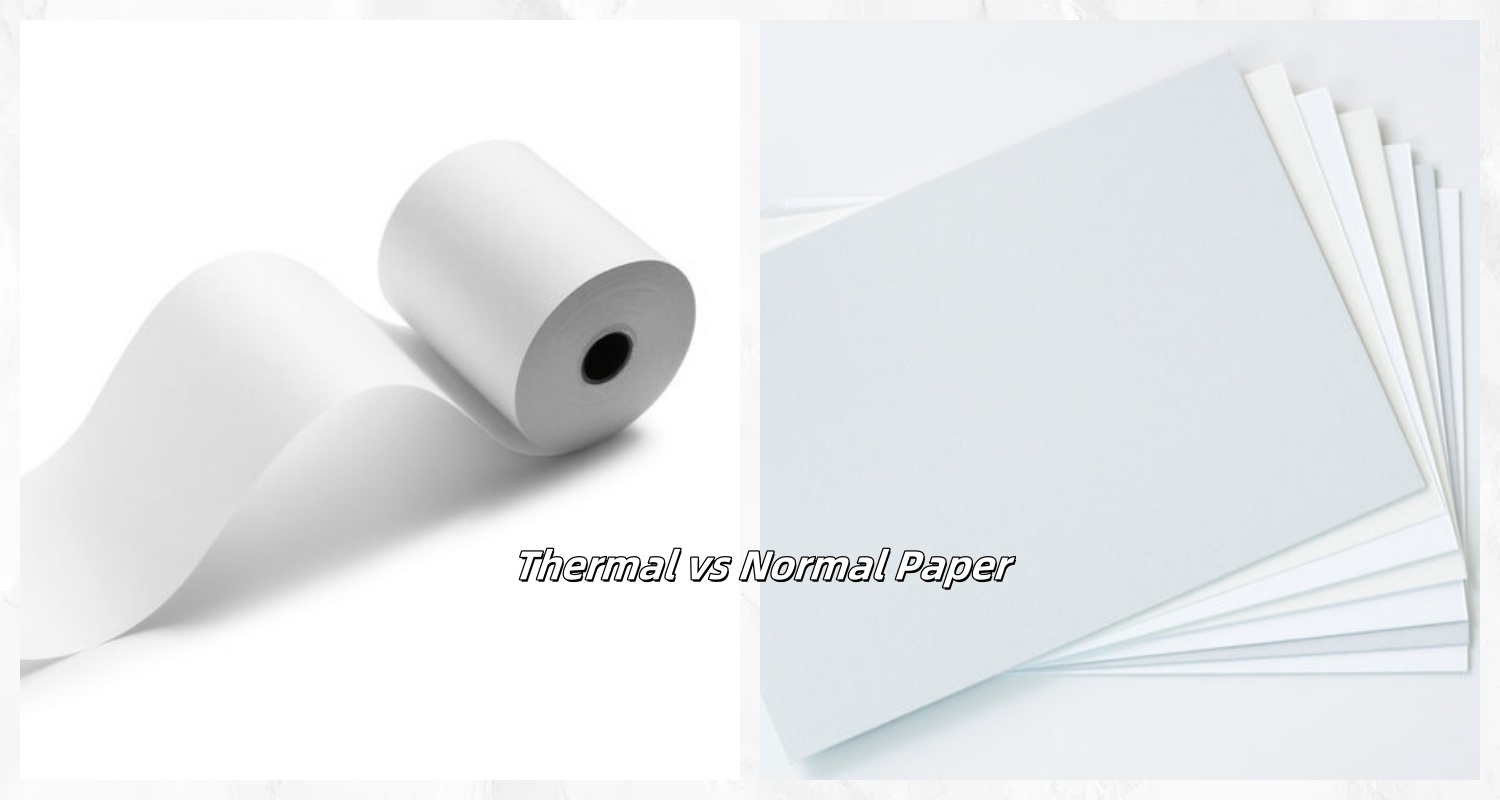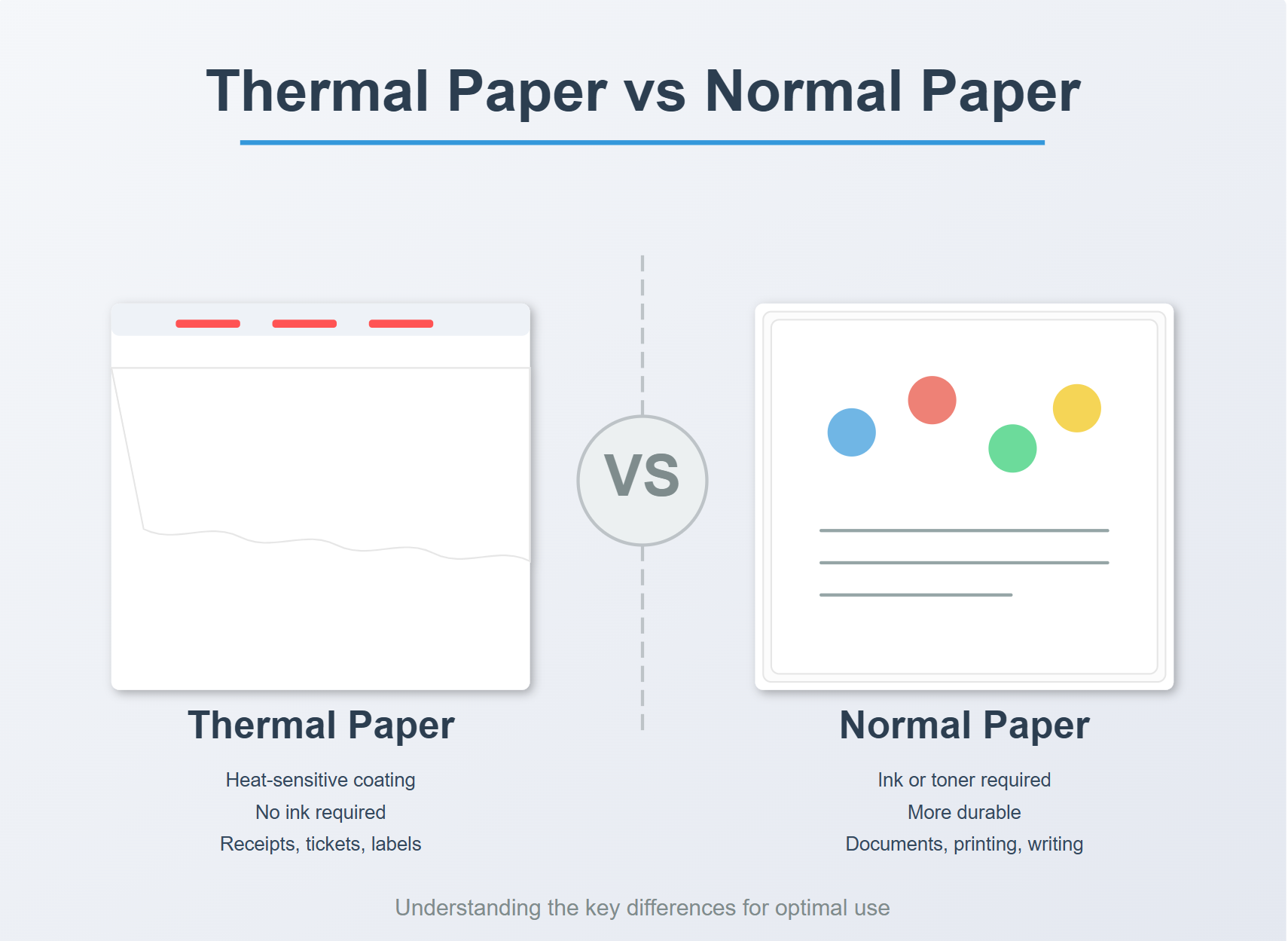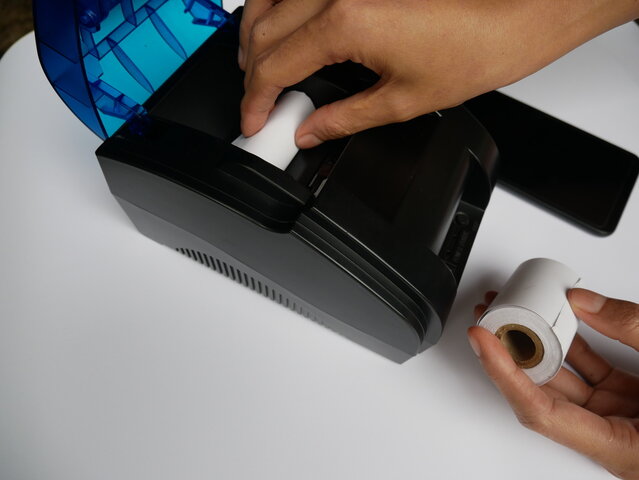
Thermal paper reacts to heat. Normal paper needs ink.Each serves a different purpose — and has different strengths.
In this post, you’ll learn how thermal and normal paper work.We’ll compare their features, uses, pros, and cons.You’ll also find tips on choosing the right paper for your needs.
What Is Thermal Paper?
Thermal paper is a specialized type of paper designed for heat-activated printing technologies. Unlike normal paper that requires ink or toner, thermal paper creates images through a chemical reaction when exposed to heat.

Composition and Manufacturing Process of Thermal Paper
Thermal paper features a sophisticated three-layer structure:
Substrate Layer - The base paper material
Base Layer - Acts as a binding element and facilitates heat transfer
Active Layer - Contains heat-sensitive chemicals (dyes and developers)
Protective Layer (premium papers only) - Prevents fading and extends print life
Premium thermal papers include an additional protective coating that significantly enhances durability and print longevity, protecting against environmental factors like UV light, water, and oils.
How Thermal Paper Works: The Science Behind Heat-Activated Printing
Thermal paper functions through a remarkable heat-activated chemical process:
When heat from the thermal print head reaches approximately 200°F (93°C), it triggers the colorless dyes in the active layer
The print head applies precise, controlled heat patterns to form images and text
This direct thermal printing process requires no ink, toner, or ribbons
Different temperature thresholds can produce varying image densities and qualities
Common Applications of Thermal Paper in Modern Life
| Application | Examples | Benefits |
| Retail | POS receipts, credit card terminals | Fast printing, economical |
| Financial | ATM receipts, bank statements | Clarity, reliability |
| Shipping | Package labels, tracking information | Durability, scanability |
| Ticketing | Transportation, events, parking | Speed, efficiency |
| Healthcare | Lab results, prescriptions, patient IDs | Clear printing, compact storage |
What Is Normal Paper?
Normal paper, often referred to as standard, plain, or bond paper, is a versatile and widely used material in everyday life. It serves as the foundation for printing, writing, drawing, and publishing across multiple industries.

Composition and Production of Standard Paper
Normal paper's composition involves several natural materials:
Primary Material: Wood pulp extracted from softwood and hardwood trees
Secondary Fibers: Plant-based materials like cotton, hemp, or recycled paper
Manufacturing Process: Involves pulping, bleaching, pressing, and drying
Additives: May include sizing agents, fillers, and optical brighteners
The manufacturing process transforms these raw materials into various paper grades:
| Paper Grade | Weight Range | Common Uses |
| Lightweight | 60-80 gsm | Newspapers, flyers |
| Medium | 80-120 gsm | Office documents, books |
| Heavyweight | 120-300+ gsm | Business cards, certificates |
How Normal Paper Interacts with Different Printing Technologies
Unlike thermal paper that requires heat, normal paper works with multiple printing methods:
Inkjet Printing: Liquid ink droplets are sprayed onto the paper surface and absorbed into the fibers
Laser Printing: Dry toner particles are fused to the paper using heat and pressure
Absorption Mechanics: Paper porosity and surface sizing determine how ink penetrates and adheres
Quality Factors: Paper brightness, opacity, and texture significantly impact print quality and image clarity
Everyday Applications of Normal Paper
Normal paper serves countless practical purposes:
Professional: Reports, contracts, presentations, business communications
Marketing: Brochures, flyers, direct mail, promotional materials
Personal: Letters, greeting cards, invitations
Academic: Textbooks, notebooks, assignments, examinations
Creative: Drawing, painting, crafting, scrapbooking
Its compatibility with different printers and wide range of sizes and textures make it an essential tool for both functional and creative purposes.
Thermal Paper vs Normal Paper: A Side-by-Side Comparison

Understanding the differences between thermal paper and normal paper helps you choose the best option for your needs. Below is a comprehensive comparison across key features:
Comparison Table
| Feature | Thermal Paper | Normal Paper |
| Printing Method | Heat-based (no ink or toner needed) | Uses inkjet or laser printers |
| Heat/Light Sensitivity | Highly sensitive; fades over time | Low sensitivity; maintains print quality longer |
| Durability | Less durable; prone to scratches or fading | More durable; withstands handling and environmental stress |
| Cost | More expensive due to special coating | Generally more affordable |
| Printer Compatibility | Requires thermal printer | Works with inkjet and laser printers |
| Image Quality | Sharp, monochrome text and images | Supports high-resolution and full-color printing |
| Printing Speed | Very fast, ideal for high-volume needs | Slower, especially with complex or colored prints |
| Storage & Handling | Lightweight, portable, easy to store | Heavier, needs more storage space |
| Environmental Impact | BPA-free options available, but limited recyclability | Recyclable, but requires ink and toner |
Key Takeaways
Thermal paper is ideal for quick, high-volume, short-term prints like receipts and labels.
Normal paper suits documents that require longevity, color printing, or professional presentation.
Advantages of Thermal Paper Over Normal Paper
Thermal paper offers several advantages that make it a smart choice for businesses with high-volume printing needs. From cost savings to environmental benefits, it’s a practical alternative to traditional paper printing systems.
Superior Performance Benefits
Long-lasting Prints
High-quality thermal paper, particularly thermal transfer variants, produces prints that can withstand challenging conditions:
Enhanced Durability: Resistant to oils, water, and UV radiation
Fade Resistance: No ink to smudge or fade over time
Environmental Tolerance: Performs well in high humidity and extreme temperatures
Record Longevity: Businesses can preserve transaction records for years
Faster Output for High-Volume Environments
Thermal printing significantly outperforms traditional printing methods in speed:
Immediate image creation without drying time
Ideal for high-traffic retail environments
Perfect for time-sensitive applications like tickets and labels
Reduced customer wait times at checkout
Operational Advantages
| Benefit | Thermal Paper | Normal Paper |
| Cost Efficiency | No ink cartridges or ribbon replacements | Ongoing ink/toner expenses |
| Maintenance | Fewer moving parts, lower upkeep costs | Regular maintenance required |
| Space Requirements | Lightweight, compact storage | Bulkier, requires more space |
| Handling | Simple loading process, fewer technical issues | More complex paper feeding systems |
| Mobility | Easily transported for on-the-go applications | Heavier, less portable |
Environmental Considerations
Thermal paper technology has evolved to address environmental concerns:
BPA-Free Options: Many manufacturers now offer thermal paper without harmful Bisphenol A
Recyclability: Modern thermal paper can be recycled alongside regular paper waste
Resource Conservation: No additional resources spent on ink or toner production
Energy Efficiency: Thermal printers typically consume less power than laser printers
These combined advantages make thermal paper the optimal choice for businesses prioritizing efficiency, mobility, and operational cost management, particularly in retail, hospitality, and logistics sectors.
Choosing the Right Thermal Paper
Selecting the right thermal paper is essential for print clarity, printer longevity, and cost-efficiency. With various sizes, coatings, and quality levels available, making an informed choice ensures reliable performance in daily operations.

Size Selection: Finding the Perfect Fit
Thermal paper rolls don't come in standardized dimensions, making size selection crucial:
Printer Compatibility: First determine your printer's exact width requirements
Roll Dimensions: Consider both width and diameter limitations of your device
Length Efficiency: Longer rolls (80mm x 80mm) are more economical for high-volume printing
Application Suitability: Different applications (POS, ATM, shipping labels) require specific sizes
Quality Assessment: What Makes Premium Thermal Paper
The quality of thermal paper significantly impacts print clarity and longevity:
Testing Thermal Paper Quality:
Tear a sample piece of thermal paper
Heat the back using a lighter
High-quality paper turns black with a slight green tint
The color block should appear uniform throughout
| Quality Indicator | Premium Thermal Paper | Economy Thermal Paper |
| Appearance | Slightly greenish tint, moderate reflection | Bright white, highly reflective |
| Thickness | Higher GSM (grams per square meter) | Lower GSM, feels thinner |
| Protective Coating | Additional top layer prevents fading | Minimal or no protective layer |
| Heat Test Result | Black with green tint, uniform coloration | Browns unevenly, inconsistent |
| Print Longevity | 5-7+ years under proper storage | 6-18 months before significant fading |
Pricing Considerations: Value vs. Cost
While comparing thermal paper options:
Quality-Price Relationship: Unreasonably low prices often indicate inferior quality
Brand Reputation: Established manufacturers typically offer more consistent quality
Bulk Purchasing: Volume discounts can reduce costs without sacrificing quality
Total Value Assessment: Consider print longevity and printer maintenance when calculating real cost
BPA-Free Options: Healthier Alternatives
Health-conscious businesses should consider BPA-free thermal paper:
Health Concerns: Traditional thermal papers contain Bisphenol A (BPA), linked to cancer risk, decreased fertility, and birth defects
Regulatory Compliance: Some regions now regulate or ban BPA in thermal papers
Performance Equivalence: Modern BPA-free formulations perform comparably to traditional options
Marketing Advantage: Offering BPA-free receipts can be a positive selling point for eco-conscious customers
Selecting the right thermal paper involves balancing these considerations against your specific business needs and budget constraints.
Write In End
Thermal paper uses heat; normal paper uses ink or toner.
Thermal is faster but fades. Normal lasts longer and prints in color.
Each paper type has strengths for different uses.
Choose based on your needs—speed, cost, durability, or print quality.
Picking the right paper helps avoid damage and improves results.
FAQs
Q: Can I use normal paper for a thermal printer?
A: No, normal paper cannot be used in thermal printers because it lacks the specialized heat-sensitive chemical coating that reacts to heat from thermal print heads. Thermal printers require specially coated thermal paper to function properly.
Q: How much is thermal paper compared to normal paper?
A: Thermal paper typically costs more, with rolls priced around 80 cents for 220-230 feet, while regular paper costs approximately 40 cents for 150-foot rolls, making thermal paper more expensive even considering the length difference.
Q: Why is thermal paper so expensive?
A: Thermal paper is expensive due to its specialized chemical coating, rigorous quality control requirements, and market demand-supply dynamics. The manufacturing process requires specific heat-sensitive chemicals and additional production steps compared to normal paper.
Q: Can thermal paper be used in regular printers?
A: No, thermal paper cannot be used in regular printers. Attempting this can damage your printer as the heat generated could cause the thermal paper to react improperly or even ignite, and its chemical coating can harm print heads not designed for thermal media.
Q: Are there any health risks associated with handling thermal paper?
A: Yes, traditional thermal paper contains Bisphenol A (BPA), which has been linked to serious health concerns including increased cancer risk, decreased fertility, diabetes, and birth defects. BPA-free thermal paper options are now available as safer alternatives.
Q: Is thermal paper recyclable?
A: Yes, thermal paper is recyclable. Modern thermal papers, especially eco-friendly versions, can be recycled alongside regular paper waste, making them an environmentally sustainable option for businesses concerned about their ecological footprint.
Q: Can thermal paper be used for legal documents?
A: Thermal paper is generally not recommended for legal documents as it's less durable than normal paper. The prints can fade over time, especially when exposed to heat, light, or certain chemicals, making it unsuitable for important long-term records.
Q: How can I tell if a paper roll is thermal or normal?
A: Thermal paper typically has a slightly greenish tint and moderate reflection, while normal paper is usually bright white. You can also test by scratching the surface with a fingernail - thermal paper will show a dark mark when scratched due to heat from friction.
Q: How should thermal paper rolls be stored?
A: Thermal paper should be stored in cool, dry conditions away from direct heat, sunlight, and fluorescent lighting. Proper storage prevents premature darkening of the paper and extends the life of printed receipts and documents.
Q: What causes thermal paper to turn black?
A: Thermal paper turns black when heat activates the chemical coating on its surface. The invisible dyes and developers in the coating react at specific temperatures, creating visible marks. This same reaction occurs unintentionally when thermal paper is exposed to excessive heat sources.




























